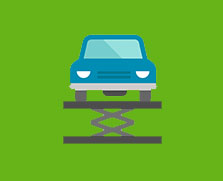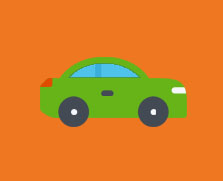Citroen C4 Cactus MOT Results
Registered in 201780.4% pass rate
from 5,911 tests in 2021
(55% worse than other 2017 cars)
Pass rate by mileage
More MoT Results
Failure rates by item
Here you can drill down into the failure rates for each item on the test. We've also compared the rates to the average results for 2017 cars and highlighted areas where the Citroen C4 Cactus is unusually good or bad.
-
9.5% fail on
Visibility
(160% worse than other 2017 cars)
- 7.1% fail on Wipers (160% worse than other 2017 cars)
- 2.6% fail on Washers (170% worse than other 2017 cars)
-
0.10% fail on
Condition of glass
- 0.10% fail on Windscreen
- 0.051% fail on Bonnet
-
4.5% fail on
Lamps, reflectors and electrical equipment
(71% worse than other 2017 cars)
-
2.3% fail on
Headlamp aim
(74% worse than other 2017 cars)
- 2.1% fail on Headlamp aim (66% worse than other 2017 cars)
- 0.17% fail on Headlamp aim not tested (2 times worse than other 2017 cars)
-
1.7% fail on
Headlamps
(2 times worse than other 2017 cars)
- 1.7% fail on Headlamp (3 times worse than other 2017 cars)
- 0.64% fail on Registration plate lamp(s) (2 times worse than other 2017 cars)
- 0.27% fail on Stop lamp
-
0.20% fail on
Direction indicators
-
0.20% fail on
Flashing type
- 0.17% fail on Side repeaters
- 0.034% fail on Individual direction indicators
-
0.20% fail on
Flashing type
-
0.034% fail on
Reversing lamps
- 0.034% fail on Reversing lamps
-
0.017% fail on
Electrical equipment
- 0.017% fail on Battery(ies)
-
2.3% fail on
Headlamp aim
(74% worse than other 2017 cars)
-
3.7% fail on
Tyres
- 2.1% fail on Tread depth (38% worse than other 2017 cars)
- 1.6% fail on Condition
- 0.12% fail on Size/type
-
2.6% fail on
Body, chassis, structure
(7 times worse than other 2017 cars)
- 1.2% fail on Exhaust system (15 times worse than other 2017 cars)
-
1.2% fail on
Transmission
(10 times worse than other 2017 cars)
-
1.1% fail on
Drive shafts
(10 times worse than other 2017 cars)
- 1.1% fail on Joints (10 times worse than other 2017 cars)
-
0.068% fail on
Prop shafts
(11 times worse than other 2017 cars)
- 0.068% fail on Joints (16 times worse than other 2017 cars)
-
1.1% fail on
Drive shafts
(10 times worse than other 2017 cars)
-
0.20% fail on
Seats
(10 times worse than other 2017 cars)
- 0.19% fail on Passenger's seat (20 times worse than other 2017 cars)
- 0.017% fail on Driver's seat
-
0.017% fail on
Fuel system
- 0.017% fail on Pipe
-
0.017% fail on
Body
- 0.017% fail on Other body component
- 0.017% fail on Undertray
-
2.3% fail on
Brakes
-
1.6% fail on
Mechanical brake components
-
1.3% fail on
Brake linings and pads
- 1.3% fail on Brake pads
- 0.017% fail on Brake linings
-
0.61% fail on
Brake discs and drums
(78% worse than other 2017 cars)
- 0.61% fail on Brake discs (78% worse than other 2017 cars)
-
1.3% fail on
Brake linings and pads
-
0.64% fail on
Brake performance
-
0.36% fail on
Service brake performance
-
0.36% fail on
Rbt
- 0.34% fail on Service brake performance
- 0.017% fail on Service brake imbalance
-
0.36% fail on
Rbt
-
0.12% fail on
Parking brake efficiency (sp)
- 0.12% fail on Rbt (sp)
-
0.10% fail on
Service Brake Efficiency (sp)
-
0.10% fail on
Rbt (sp)
- 0.068% fail on Service brake performance
- 0.034% fail on Service brake imbalance
-
0.10% fail on
Rbt (sp)
-
0.10% fail on
Parking brake performance
-
0.10% fail on
Rbt
- 0.10% fail on Parking brake performance
-
0.10% fail on
Rbt
- 0.051% fail on Brake performance not tested
-
0.36% fail on
Service brake performance
-
0.085% fail on
Service brake pedal or hand lever
- 0.068% fail on Pedal
- 0.017% fail on Hand lever
-
0.068% fail on
ABS / EBS / ESC
- 0.051% fail on Anti-lock braking system
- 0.034% fail on Electronic stability control
-
0.017% fail on
Parking brake control
- 0.017% fail on Lever
-
0.017% fail on
Hydraulic systems
- 0.017% fail on Brake fluid
- 0.017% fail on Flexible brake hoses
-
0.017% fail on
Brake actuators (including spring brakes or hydraulic cylinders)
- 0.017% fail on Hydraulic brake callipers
-
1.6% fail on
Mechanical brake components
-
0.54% fail on
Noise, emissions and leaks
-
0.51% fail on
Exhaust emissions
-
0.30% fail on
Spark ignition
- 0.17% fail on Malfunction indicator lamp
- 0.10% fail on Catalyst emissions
- 0.034% fail on Emissions not tested
-
0.22% fail on
Compression ignition
- 0.15% fail on Malfunction indicator lamp
-
0.034% fail on
Emission control equipment
(14 times worse than other 2017 cars)
- 0.017% fail on Catalytic converter
- 0.017% fail on Other emission control equipment
- 0.034% fail on On or after 01/01/2014
- 0.017% fail on Emissions not tested
-
0.30% fail on
Spark ignition
-
0.034% fail on
Fluid leaks
- 0.034% fail on Engine oil leaks
-
0.51% fail on
Exhaust emissions
-
0.36% fail on
Suspension
(60% better than other 2017 cars)
-
0.27% fail on
Suspension arms
- 0.15% fail on Ball joint
- 0.068% fail on Pins and bushes
- 0.034% fail on Ball joint dust cover
- 0.017% fail on Suspension arm
-
0.034% fail on
Springs
(90% better than other 2017 cars)
-
0.034% fail on
Coil springs
(90% better than other 2017 cars)
- 0.034% fail on Coil spring (90% better than other 2017 cars)
-
0.034% fail on
Coil springs
(90% better than other 2017 cars)
-
0.034% fail on
Anti-roll bars
- 0.017% fail on Ball joint
- 0.017% fail on Linkage ball joints
- 0.017% fail on Wheel bearings
-
0.27% fail on
Suspension arms
-
0.20% fail on
Seat belts and supplementary restraint systems
-
0.15% fail on
Seat belts
- 0.12% fail on Condition
- 0.017% fail on Attachment
- 0.017% fail on Requirements
- 0.051% fail on SRS malfunction indicator lamp
-
0.15% fail on
Seat belts
-
0.15% fail on
Identification of the vehicle
- 0.15% fail on Registration plates
-
0.12% fail on
Steering
-
0.10% fail on
Steering linkage components
- 0.068% fail on Track rod end
- 0.017% fail on Drag link end
- 0.017% fail on Locking devices
-
0.017% fail on
Steering gear
- 0.017% fail on Steering rack
-
0.10% fail on
Steering linkage components




